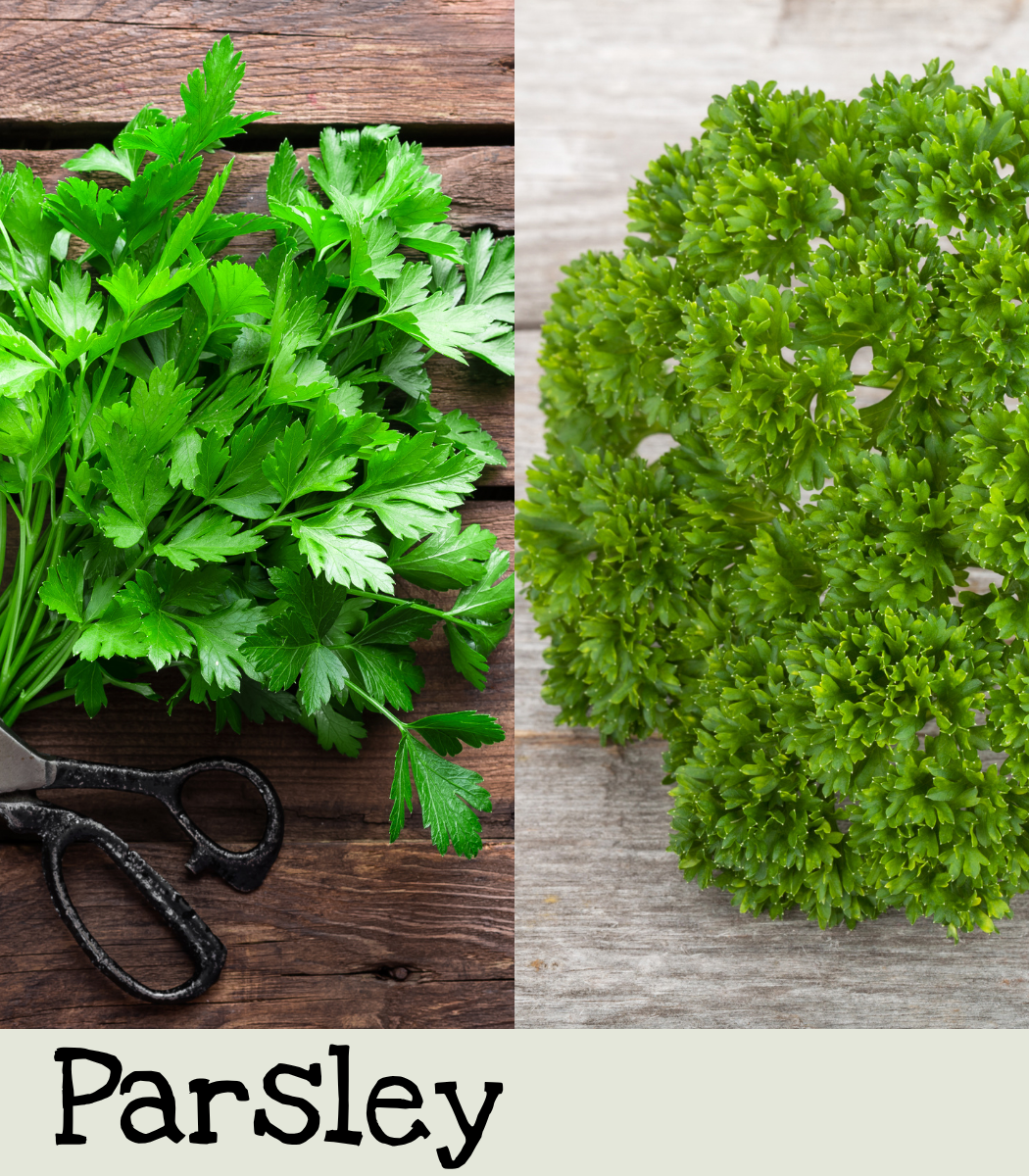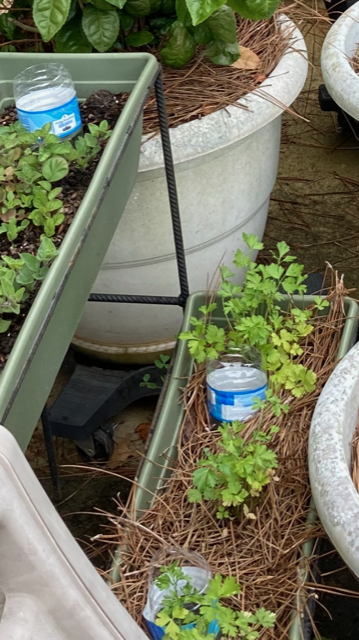
Parsley
Parsley brings a fresh bright flavor to dishes and is often used as a garnish. The rooted parsley is a great root crop perfect for soups and stews.
|
Dk Green Italian; Giant of Italy; Italian; WEGA |
|
Petroselinum crispum Italian: Petroselinum crispum latifolium |
|
Intermediate to Easy |
|
Intermediate |
|
2-3 years if properly stored |
|
Biennial |
|
Can take 3 weeks or more |
|
Optional: soak overnight |
|
1/4 – 1/2 inch |
|
Full sun to part shade |
|
February, March, and April |
|
Yes |

Growing Tips




When to Start
Spring: Start indoors about 6-8 weeks before transplanting. (Mid-Feb – Mid-March for Jefferson, GA)
Direct sow/transplant: after the danger of frost has passed. (May 1 for Jefferson, GA)
How to Grow
While parsley can be sown directly in the garden as soon as the soil is manageable in spring, the best time to plant parsley seeds is to sow them indoors 6-8 weeks before the last frost. Transplant them after hardening off and the danger of frost has passed. Or direct sow the seeds after the danger of frost has passed.
An option to aid germination is to soak the seeds overnight. When planting parsley, simply sprinkle seeds on top of the soil and mist well with water. Keep the soil moist throughout the germination process.
Parsley Care
Plant in full sun to partial shade in well-draining soil. Once the seeds have sprouted and have grown to 3-4 inches tall, thin them down to only one or two plants per pot or 3-6”. Keep the soil moist but not soggy, especially during the hot months of summer. Parsley will overwinter and bloom in the early spring.
It is one of the earliest spring plants to flower and is a good nectar source for pollinators. Once the plant starts to bolt the leaves are no longer edible due to the change in flavor. Parsley is also a host plant for the Easter Tiger Swallowtail butterfly, the state butterfly of GA.
Harvest
You can harvest the leaves throughout the growing season, however, they will have the most flavor in the cool spring months. Harvest in the mornings for peak flavor. Only cut a few leaves at a time to prevent over-harvesting and to encourage new growth for a continuous supply.
How to use
When harvesting parsley, harvest the stem and not just the leaves. Most of the flavor is in the stem. It can be added to salads and used as a garnish. When added to soups, stews, and other dishes it can brighten the flavor of that dish. It is best to add parsley at the very end of the cooking process for the best flavor. Parsley is often added to roasted or pan-fried potatoes.
To make tea: Add 2 tablespoons of fresh or dried leaves to 1 cup of hot water. Steep briefly as parsley will loose its flavor if exposed to heat for long periods. Strain out leaves. I haven’t tried this one yet. I don’t think I like parsley enough to drink straight parsley water, so I’d try infusing it into black tea and mixing in some other herbs to boost the flavor.
Pro Tip!
Incompatibles: None
Grows well with: Asparagus, corn, peppers, and tomatoes
My personal experience
I love to put fresh parsley on dishes as a garnish even though I thought it didn’t have much flavor. I used to only grow curly parsley. One year, (this was before I grew almost everything from seed) I couldn’t get curly parsley. As I felt I had to have some, I purchased the flat-leaf Italian parsley.
I’ve never gone back! It has so much more flavor! I was so surprised that flat leave had so much flavor when the curly was almost tasteless. This variety adds more than just a bit of fresh green to dishes, but a brightness that lifts them up.
It doesn’t have the same flavor dried, so I don’t dry as much of it as I do my other herbs. I water it every morning and I grow 3 seedlings from seed each year. This is the perfect amount for the window box and my needs.
Problems and Plans
The only thing I have to watch for is butterfly eggs and larva. I will pick them off as I rely on these plants for eating. However, as it’s also a host plant, I plan on growing a bunch that I don’t rely on for eating in my flower bed. This way the caterpillars can have it and they’ll have a nectar plants for when the emerge as adults! Plus if any survive, I’ll be able to save seeds!

Seed Saving

Isolation Distance
Insect-dependent and biennial, parsley can cross other parsley varieties and should be separated by 1 mile for reliable distance isolation. Allow seeds to mature and dry on the plants before harvesting.
Instructions
Plants will bloom in the 2nd year by sending up stalks to 2-3′ tall bearing compound umbels of greenish-yellow flowers. Unfortunately, leaves lose good flavor in the second year when plants are in flower.
Once pods or husks have been harvested, store them in a dry place and wait until they are thoroughly dry. When the pods or husks are dry enough they will easily crumble between your hands. Crumble the pods or husks until all the seeds are released.
Seeds and finer chaff are easy to separate by a variety of methods. One way is to use two screens of varying mesh, one a little smaller than the seeds and the other a little larger. The first screen lets anything smaller than the seeds fall through, and the second lets the seeds through and stops anything larger.
Features
- Dark Green Italian: Use in salad dressings, poultry, soups, and as an ingredient in pesto
- Giant of Italy: The leaves are huge, dark green, with excellent flavor. A very high-yielding flat-leaf type.
- Italian: Heirloom. It has a more robust flavor and smoother texture than curly parsley. Good for enhancing dishes and salads.
- WEGA: A curly variety that is uniform and refined.

Parsley is biannual and will flower in the 2nd year. The leaves will lose their flavor during seed production.
To keep a continual supply of fresh parsley and fresh seeds every year:
- Keep enough space open for this year’s new seedlings.
- Once the 2nd year’s parsley seeds have been harvested, remove plants to make room for next year’s seedlings. This space will remain open for the next year’s seedlings.
- Keep the cycle going!
Try planting rooted parsley in part shade if you want to wait until a fall frost to harvest.
Parsley root seeds can benefit from cold stratification. If you are struggling to get seeds to germinate, try placing the seeds in the refrigerator for a few weeks. Then follow the above planting instructions.
Sources:
Gardeningknowhow.com
savvygardening.com
en.garden-landscape.com
Helmer, Jodi. Growing Your Own Tea Garden: the Guide to Growing and Harvesting Flavorful Teas in Your Backyard. Fox Chapel Publishers International Ltd., 2019.
